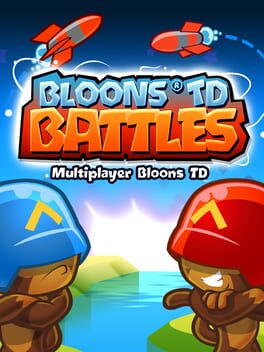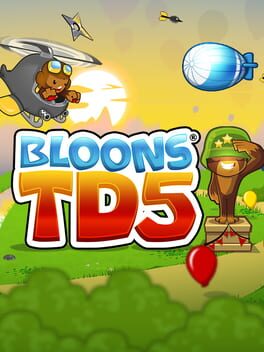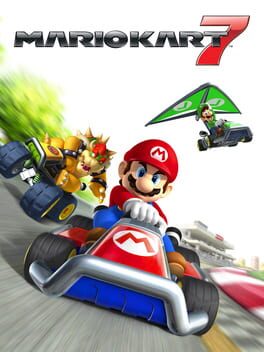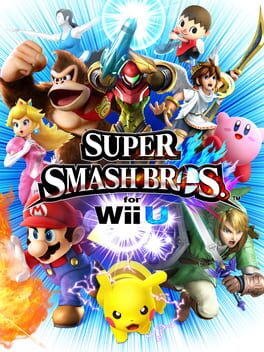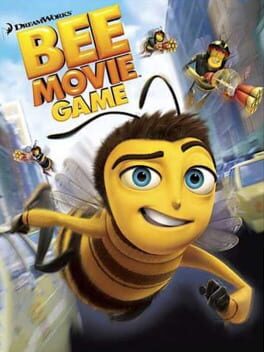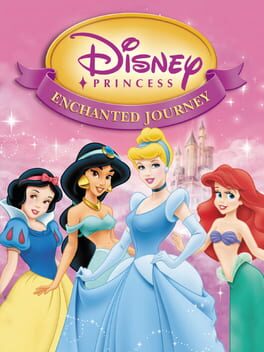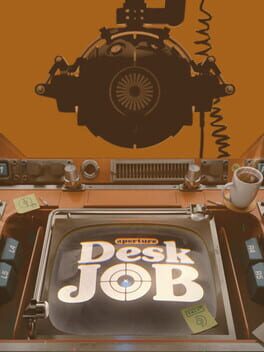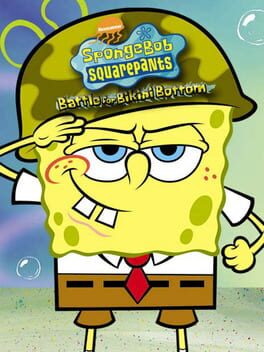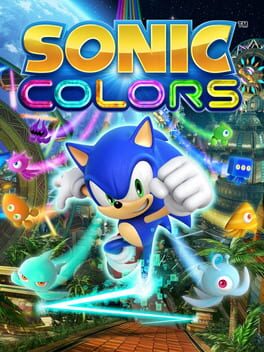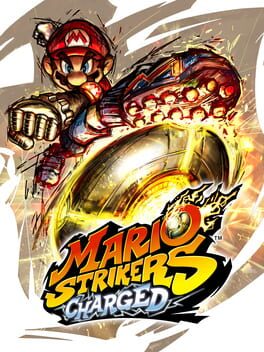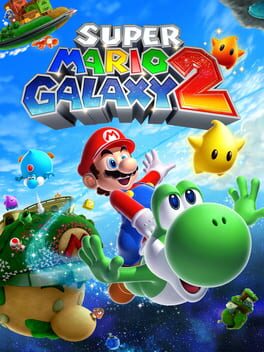willn46
2013
A pretty neat way of translating BTD's gameplay into a multiplayer format. It has some annoying microtransaction stuff compared to 5 and admittedly isn't the most engaging game in the world, but it's still a good time every now and then.
Also, why is this marked as a standalone expansion? It should be a separate game imo.
Also, why is this marked as a standalone expansion? It should be a separate game imo.
2011
2011
I remember seeing a meme at one point made by a kid who was disappointed that Spongebob, Minecraft Steve, and Freddy Fazbear weren't added as DLC. Whatever that kid's doing now, I hope they're happy at least one of their characters got added to Smash Ultimate.
That kid is probably older than me holy shit
That kid is probably older than me holy shit
2007
My older sister never got into video games. None of the games I played as a kid ever clicked with her, and as she got older, her hobbies shifted more towards reading books (I know, how dare she). This game was one of the few exceptions, as she played it quite a bit back in the day, and I went through it a couple times, too.
Anyway, it's, uh...not good. From what I can recall, the gameplay is very basic stuff centered around Disney princesses that isn't too interesting. My strongest memories of this game are making a bald player character (which is comedy gold when you're like, 5), and the game freezing up at one point, forcing us to reset. No wonder my sister never got into gaming.
Anyway, it's, uh...not good. From what I can recall, the gameplay is very basic stuff centered around Disney princesses that isn't too interesting. My strongest memories of this game are making a bald player character (which is comedy gold when you're like, 5), and the game freezing up at one point, forcing us to reset. No wonder my sister never got into gaming.
2018
2022
If I were a sick, twisted human being, I would say this game is better than Banjo-Kazooie.
Luckily, I'm relatively normal, but I still think this game is very good. The theming from the show leads to great writing and fun locations, core gameplay's pretty solid (especially Sandy's), and the music and visuals hold up really well. There are some rough spots with the controls and some really bad spatulas, but overall I'd say it's one of the better licensed games out there.
Luckily, I'm relatively normal, but I still think this game is very good. The theming from the show leads to great writing and fun locations, core gameplay's pretty solid (especially Sandy's), and the music and visuals hold up really well. There are some rough spots with the controls and some really bad spatulas, but overall I'd say it's one of the better licensed games out there.
2010
Back in early 2017, I was at a bit of a low point in my personal life, and a few games in combination with my discovery of YouTube helped get me out of it. This, Kirby's Return to Dreamland, and Battle for Bikini Bottom were the main games in question, so it'll always hold a special place in my heart for that alone.
But even then, this is a really good Sonic game. It takes the boost gameplay and manages to switch it up without feeling gimmicky thanks to the introduction of the wisps. Not to mention, it looks and sounds amazing to this day. Sure, some levels aren't the greatest, the bosses are lame and the writing sucks, but in spite of all that it manages to be good, great, awesome, outstanding, amazing even.
But even then, this is a really good Sonic game. It takes the boost gameplay and manages to switch it up without feeling gimmicky thanks to the introduction of the wisps. Not to mention, it looks and sounds amazing to this day. Sure, some levels aren't the greatest, the bosses are lame and the writing sucks, but in spite of all that it manages to be good, great, awesome, outstanding, amazing even.
2002
Super Mario Sunshine is an odd game. It has a lot of good qualities and I could easily see it ranking alongside people’s favorite games of all time, but there’s also a lot of stuff holding it back, arguably more than any other 3D Mario. But, as a fair game critic, I should start with the positives.
Mario Sunshine’s biggest strength is in its personality. Right from the title screen, the game introduces an offbeat tone in both design and visuals, letting players mess around with Mario’s moveset and making them physically select a file. The aesthetics are beautiful, with vibrant tropical locales that still hold up visually. The soundtrack has a unique style that’s both catchy and fitting to the environment. It’s even the only mainline Mario game to feature voice acting! Bad voice acting, yes, but the voices are indeed acting!
There are some really good character designs here, too. Newly introduced series icons like the Piantas, Petey Piranha, and Bowser Jr join sleeper hits like Cataquacks and Electro Koopas to form an all-star cast. Also, I love how E. Gadd’s ties to FLUDD and the Magic Paintbrush connect this game to Luigi’s Mansion, showcasing a continuity Mario hasn’t really done since…Dream Team? Sunshine isn’t the most charming of Mario’s Gamecube outings; it’s outdone by the sports titles and especially TTYD, but the vibes are still as fresh as the water from Mario’s jetpack.
Speaking of which, FLUDD is a great addition to the gameplay. Not only does he fit with the game’s theming, but he’s a wonderful tool in Mario’s arsenal. The spraying mechanics are fun to use, serving as both a means of attack and of increasing momentum. Plus, the additional airtime provided by the hover nozzle is a nifty means of getting around. The rocket and turbo nozzles are also pretty fun to use, offering great vertical and horizontal utility respectively. And when you fully understand how FLUDD works, movement becomes an absolute thrill ride, where Mario hops, slides, and speeds along at an exhilarating rate…
…Which makes it suck when the game forcibly removes these options. Scattered throughout Sunshine are a series of self-contained platforming challenges over a great blue void. This might sound like a great chance to use that movement I mentioned, but here’s the thing: You can’t use FLUDD in these sections. Now, on paper this is a fine enough idea. FLUDD is the game’s central mechanic, and it’s only fair that it spends the entire game fleshing him out as much as possible. And removing that mechanic is a good way of doing so.
There’s just one problem: Remember that fluid movement I mentioned earlier? Yeah, see how much fluid you get without your fancy water bottle. Mario Sunshine’s movement really wasn’t built around not having FLUDD, at least not in the context of precise platforming, which is the exact situation where they remove him. It just feels awkward trying to get around without him, the game’s odd lack of a long jump especially making traversal a lot more frustrating. And on top of that, these sections harshly punish your mistakes. One wrong move and you fall into a pit and have to start the section all over again. Oh, and God forbid you lose all your lives and have to trek back through the level, wasting even more of your time.
Okay, so the no-FLUDD sections are frustrating, but so what? Every Mario game has at least a few bad levels. Just skip them! Oh, you sweet, stupid summer child, let me introduce you to one of Sunshine’s other major blunders: the change in structure. Now, Mario 64 was very generous with its completion requirements, only requiring 70 of its 120 stars in order to face the final boss. Plus, you could get a level’s Power Stars in any order. This meant that if you didn’t like a level, that’s fine. You could just do another one. Sunshine, for some odd reason, lays out an incredibly specific goal for the player: you have to do the first 7 missions in every level in order to reach the ending. All those sections that really suck? Yeah, they’re mandatory. So either slog your crusty, dehydrated plumber through platformer purgatory or give up and haul your ass back to Kirby Air Ride (Please note that I hold no ill will against Kirby Air Ride or its playerbase).
Another victim of the game’s structure is the optional shines. Now, optional content in games is cool, but usually there’s some kind of reward attached to it. Like, oh, I don’t know, something that helps you progress in the story. Mario Sunshine throws all that out the window, snapshots its corpse, and slaps it on a custom-printed postcard from the Land of Sensible Design. Yeah, I wish I was there, too. So many neat ideas in Sunshine are gimped by their complete uselessness in the face of the game’s ultimate goal. The shines you can earn in the overworld? Sorry, their purpose is in another castle. The secret shines scattered throughout the levels? The real secret is they’re a waste of time. The blue coins? Please, you’re better off buying crypto. Even the fact that shines help unlock levels (I think) is redundant because the main missions already give you more than enough to unlock all of them.
Let’s talk about those main missions some more, because Sunshine’s level design is…odd, to say the least. Remember when I praised Mario Galaxy for how its tight level design got the most out of its simple movement? Sunshine’s kind of the opposite. You have a lot of movement options, but every level either removes your access to them or plops them into an uninteresting layout. In what I can only assume was due to the game’s rushed development, Sunshine’s levels sit at an awkward midpoint between 64’s open-ended playgrounds and Galaxy’s linear, mission-based structure. The levels are technically open, sure, but you have to do all the objectives in a specific order, one at a time. Unlike the Galaxy games, though, the bulk of the level often remains largely the same, just with an objective tacked on at a different point, so you don’t really feel the variety. For a game all about cleaning, they paid shockingly little attention to polish.
But for what it’s worth, the missions you do within the main levels are fine. They reuse a lot of objectives, but they do a good enough job being engaging and the movement carries it a fair bit. Plus, this game features Yoshi’s first 3D appearance, even if it is by far the weakest and it portrays him as oddly soluble. And unlike Mario 64, the bosses don’t suck, even if the final stretch of the game is god-awful. That’s the thing about Sunshine. It’s not a bad game. Hell, I’m even tempted to call it good. But it really squanders a lot of its best ideas with an array of baffling design decisions and a development cycle that leaves it feeling less finished than the GameCube’s actual tech demo. It had the potential to reach the sky, but for every time it came close, it just got burned.
Mario Sunshine’s biggest strength is in its personality. Right from the title screen, the game introduces an offbeat tone in both design and visuals, letting players mess around with Mario’s moveset and making them physically select a file. The aesthetics are beautiful, with vibrant tropical locales that still hold up visually. The soundtrack has a unique style that’s both catchy and fitting to the environment. It’s even the only mainline Mario game to feature voice acting! Bad voice acting, yes, but the voices are indeed acting!
There are some really good character designs here, too. Newly introduced series icons like the Piantas, Petey Piranha, and Bowser Jr join sleeper hits like Cataquacks and Electro Koopas to form an all-star cast. Also, I love how E. Gadd’s ties to FLUDD and the Magic Paintbrush connect this game to Luigi’s Mansion, showcasing a continuity Mario hasn’t really done since…Dream Team? Sunshine isn’t the most charming of Mario’s Gamecube outings; it’s outdone by the sports titles and especially TTYD, but the vibes are still as fresh as the water from Mario’s jetpack.
Speaking of which, FLUDD is a great addition to the gameplay. Not only does he fit with the game’s theming, but he’s a wonderful tool in Mario’s arsenal. The spraying mechanics are fun to use, serving as both a means of attack and of increasing momentum. Plus, the additional airtime provided by the hover nozzle is a nifty means of getting around. The rocket and turbo nozzles are also pretty fun to use, offering great vertical and horizontal utility respectively. And when you fully understand how FLUDD works, movement becomes an absolute thrill ride, where Mario hops, slides, and speeds along at an exhilarating rate…
…Which makes it suck when the game forcibly removes these options. Scattered throughout Sunshine are a series of self-contained platforming challenges over a great blue void. This might sound like a great chance to use that movement I mentioned, but here’s the thing: You can’t use FLUDD in these sections. Now, on paper this is a fine enough idea. FLUDD is the game’s central mechanic, and it’s only fair that it spends the entire game fleshing him out as much as possible. And removing that mechanic is a good way of doing so.
There’s just one problem: Remember that fluid movement I mentioned earlier? Yeah, see how much fluid you get without your fancy water bottle. Mario Sunshine’s movement really wasn’t built around not having FLUDD, at least not in the context of precise platforming, which is the exact situation where they remove him. It just feels awkward trying to get around without him, the game’s odd lack of a long jump especially making traversal a lot more frustrating. And on top of that, these sections harshly punish your mistakes. One wrong move and you fall into a pit and have to start the section all over again. Oh, and God forbid you lose all your lives and have to trek back through the level, wasting even more of your time.
Okay, so the no-FLUDD sections are frustrating, but so what? Every Mario game has at least a few bad levels. Just skip them! Oh, you sweet, stupid summer child, let me introduce you to one of Sunshine’s other major blunders: the change in structure. Now, Mario 64 was very generous with its completion requirements, only requiring 70 of its 120 stars in order to face the final boss. Plus, you could get a level’s Power Stars in any order. This meant that if you didn’t like a level, that’s fine. You could just do another one. Sunshine, for some odd reason, lays out an incredibly specific goal for the player: you have to do the first 7 missions in every level in order to reach the ending. All those sections that really suck? Yeah, they’re mandatory. So either slog your crusty, dehydrated plumber through platformer purgatory or give up and haul your ass back to Kirby Air Ride (Please note that I hold no ill will against Kirby Air Ride or its playerbase).
Another victim of the game’s structure is the optional shines. Now, optional content in games is cool, but usually there’s some kind of reward attached to it. Like, oh, I don’t know, something that helps you progress in the story. Mario Sunshine throws all that out the window, snapshots its corpse, and slaps it on a custom-printed postcard from the Land of Sensible Design. Yeah, I wish I was there, too. So many neat ideas in Sunshine are gimped by their complete uselessness in the face of the game’s ultimate goal. The shines you can earn in the overworld? Sorry, their purpose is in another castle. The secret shines scattered throughout the levels? The real secret is they’re a waste of time. The blue coins? Please, you’re better off buying crypto. Even the fact that shines help unlock levels (I think) is redundant because the main missions already give you more than enough to unlock all of them.
Let’s talk about those main missions some more, because Sunshine’s level design is…odd, to say the least. Remember when I praised Mario Galaxy for how its tight level design got the most out of its simple movement? Sunshine’s kind of the opposite. You have a lot of movement options, but every level either removes your access to them or plops them into an uninteresting layout. In what I can only assume was due to the game’s rushed development, Sunshine’s levels sit at an awkward midpoint between 64’s open-ended playgrounds and Galaxy’s linear, mission-based structure. The levels are technically open, sure, but you have to do all the objectives in a specific order, one at a time. Unlike the Galaxy games, though, the bulk of the level often remains largely the same, just with an objective tacked on at a different point, so you don’t really feel the variety. For a game all about cleaning, they paid shockingly little attention to polish.
But for what it’s worth, the missions you do within the main levels are fine. They reuse a lot of objectives, but they do a good enough job being engaging and the movement carries it a fair bit. Plus, this game features Yoshi’s first 3D appearance, even if it is by far the weakest and it portrays him as oddly soluble. And unlike Mario 64, the bosses don’t suck, even if the final stretch of the game is god-awful. That’s the thing about Sunshine. It’s not a bad game. Hell, I’m even tempted to call it good. But it really squanders a lot of its best ideas with an array of baffling design decisions and a development cycle that leaves it feeling less finished than the GameCube’s actual tech demo. It had the potential to reach the sky, but for every time it came close, it just got burned.
The hook is definitely the aesthetics, which were famously so over-the-top they made Nintendo backpedal towards safer portrayals of the Mario cast, but the gameplay is also really solid. It's chaotic but still requires strategy, there's good variety between the different characters, the item system is a great way to encourage careful play, and it's just satisfying to charge up and score a Megastrike. And this is a minor detail, but I love how this game uses motion controls. The fact you have to shake the controller to attack adds an element of brutality I don't think could be recaptured with buttons, like you're actually shoving your opponent in real life.
2010
Galaxy 2 doesn't have the same personal significance for me as its predecessor, but it is just as good. The story, atmosphere, and first level are downgrades, but the core gameplay is as fun as ever, the level design is top-notch, and the music and visuals are outstanding. There are some great additions, too, like Yoshi and the improved Co-Op. It is a damn shame this game wasn't in 3D All-Stars.
2007
Super Mario Galaxy is the game that made me love video games.
It wasn’t the first game I played, or even the first Mario game (that honor goes to Mario Kart Wii), but it was the first to make me see games as an art form. It’s been over 15 years since I first sat down to play it at the tender age of 4 years old, but that first play session is burned into my brain. The transition from a quiet, somber storybook into a joyous festival instantly invokes a sense of childlike wonder and turns the remotely interested into the completely invested. Then, Bowser’s attack on the Star Festival and Mario’s defeat lets veteran Mario players know this adventure will be something special, while also making the basic elements of Mario clear to new players.
Speaking of basic elements, Gateway Galaxy is a fantastic tutorial. The Star Bunny segment seamlessly introduces the game’s gravity mechanic, as well as the concepts of bushes, pipes, and craters. Rosalina’s introduction introduces a sense of mystery and quiet contemplation, and the next few planets establish the game’s phenomenal sense of epic adventure and even more gameplay elements: spinning, crystals, Launch Stars, Star Bits, enemies, Black Holes, Star Chips, Flip Switches, and electricity. And all this culminates in the rescue of the Grand Star, giving 4-year-old willn46 his first chance to save the universe and make it back home to the beautiful Comet Observatory.
But even beyond its importance to me, Mario Galaxy is simply an incredible 3D platformer. Right from the outset, Mario controls like a dream. Every input is immediately taken into account, with jumps, ground pounds, and everything in between being perfectly tuned to just feel good to use. But I’d be remiss not to mention the crown jewel of Mario’s moveset: the Spin Move. Not only is it a fantastic use of the Wii’s motion controls that feels both significant and unobtrusive (unless you have a disability that renders the controls unusable for you, in which case I am incredibly sorry), it’s also an incredibly versatile tool that’s easy to use, but has nearly limitless potential. First and foremost, the momentum-halting midair jump lets players easily recover from mistakes and adjust their positioning on the fly, giving newer players a safety net that eases them in to platforming in a 3D space. Additionally, the extra jump is great for getting places that seem just out of reach, horizontally or vertically, enabling the game to set up interesting platforming challenges and fun opportunities to skip past sections if the player is good enough. But the Spin Move isn’t just for platforming; it’s also the player’s primary means of interaction with the game. It’s used to defeat enemies, break objects, collect shells, swim faster, and so much more, and every interaction is completely intuitive (Ceave Gaming has a great video on this exact topic).
I’ve seen some people criticize the Galaxy games for not having as much movement tech as other 3D Mario games. While, yes, the movement here is much simpler than 64, Sunshine or Odyssey, I actually think it works to the game’s benefit. Not only is it much easier to learn, requiring the player to understand a few basic moves rather than a plethora of complex maneuvers, but the more limited moveset lets the game be carried entirely by its level design.
And said level design is top-notch. Like 64 and Sunshine before it, Galaxy spreads its 120 stars across multiple worlds for the plumber to tackle. But it trades their handful of levels holding a few collectibles for a supercluster of memorable locales, each one bearing a unique mechanical, visual and auditory identity. Fully committing to Sunshine’s separation of individual objectives lets the designers get the most out of a single Galaxy by introducing multiple ideas while still maintaining the level’s core themes, and splitting up the action across multiple planets allows for great variety within missions as well as between them. Plus, the introduction of mid-level checkpoints allows for longer levels that don’t feel like they drag on and gives the designers more time to play with a level’s gimmicks. The more linear level design even means the game’s limited camera rarely feels limiting. And the generous amount of Power Stars gives players plenty of freedom in choosing which levels to tackle.
This would all mean nothing if the levels themselves were boring, but luckily they couldn’t be further from that. Galaxy takes basic level tropes like Ice, Beach, and Desert levels and pushes them to their absolute limits: combining ice and fire mechanics in a lava-skating course, hiding the path to a deadly obstacle course behind an underwater cave, and navigating sand streams and tornadoes across an ocean of quicksand. And that’s not even mentioning the more original levels, like HoneyHive Galaxy, BattleRock Galaxy, or Toy Time Galaxy. Besides a few stinkers like the ball-rolling levels and some of the race levels, the level mechanics on display are consistently excellent in a way I think is only matched by this game's own sequel. Interesting obstacles like altered gravity, throwing Bob-Ombs, and launching from Sling Pods are expertly paced and explored to the fullest. Cool enemies like spinning tops, bugs that need to be ground-pounded, and giant eels combined with interesting spins on classic enemies like Goombas and Boos work wonders both from a mechanical and aesthetic standpoint. Plus the bosses are great tests of skill, utilizing a level’s mechanics in their battles on top of being tests of basic skill. Power ups are pretty fun too (besides the spring), with their own unique attributes, interactions with level gimmicks, and hazards to deal with.
And do I even need to mention the visuals and music? The artstyle is vibrant, yet the locales are consistently stunning, with great attention to detail both in the actual levels and in background elements. The character designs are excellent, both with how returning characters look and how the new characters perfectly fit in with Mario while still standing out. Plus, there are tons of cool little details and secret areas that, while they may be a little pointless, give the levels tons of personality. But even more impressive is the game’s music. The confident, orchestral themes give the game an almost cinematic feel, and yet each one perfectly fits within the level and the Mario series. There are so many standout pieces in this regard, like Good Egg Galaxy, BattleRock Galaxy, and Buoy Base Galaxy. However, the game also knows when to be more subdued and reflective, with pieces like Space Junk Galaxy and Gateway Galaxy.
And on that note…besides sparking my love of video games, there’s another reason this game means so much to me.
Back in late 2016, I made some mistakes. The details are personal, but long story short, I was a stupid 12-year-old who took his friends for granted and ended up losing them all. And for the entire month of November, going to school was absolute Hell for me because of it. In every class, I would argue with people, get teased, or get laughed at, and since a lot of it was my fault, I didn’t want to ask any teachers or my parents for help. Luckily, Thanksgiving Break rolled around eventually, and I was home safe. But at this point I realized something horrible: I had no one to turn to. All my friends left me because of my egotism, and my parents wouldn’t understand enough to help me. For that entire week, I was more or less left to think about my actions, angry at myself and at the people who hurt me. I didn’t know if I could go on, and before long, my mind went to some…dark places.
Then, on Sunday, the day before I had to go back to school, I thought I would boot up Mario Galaxy so I could at least have a little fun. I played around a little, going through some of my favorite levels, not really accomplishing much. But I enjoyed it. The game didn’t judge me. It didn’t try to hurt me. It didn’t care what I did. It was just there for me, and it was there to make me happy.
And…suddenly, I wasn’t alone anymore.
Not only did that moment save my life, not only did it bring me out of the hole I dug for myself, but it made me realize the true power of a good video game. Some people might say video games are silly little things, that they’re hunks of digital junk to give to a kid so they’ll shut up for a bit. But I think they’re more than that. Like any form of art, they can lift a person up, give them a new perspective on life, and help them move forward even when nobody else will. That moment is why I wanted to become a game designer. Because I wanted to help someone feel like someone cared for them, the same way Super Mario Galaxy helped me. Sometimes, when you’re feeling hopeless, that’s the only message you need to hear:
“Thank you so much for playing my game.”
It wasn’t the first game I played, or even the first Mario game (that honor goes to Mario Kart Wii), but it was the first to make me see games as an art form. It’s been over 15 years since I first sat down to play it at the tender age of 4 years old, but that first play session is burned into my brain. The transition from a quiet, somber storybook into a joyous festival instantly invokes a sense of childlike wonder and turns the remotely interested into the completely invested. Then, Bowser’s attack on the Star Festival and Mario’s defeat lets veteran Mario players know this adventure will be something special, while also making the basic elements of Mario clear to new players.
Speaking of basic elements, Gateway Galaxy is a fantastic tutorial. The Star Bunny segment seamlessly introduces the game’s gravity mechanic, as well as the concepts of bushes, pipes, and craters. Rosalina’s introduction introduces a sense of mystery and quiet contemplation, and the next few planets establish the game’s phenomenal sense of epic adventure and even more gameplay elements: spinning, crystals, Launch Stars, Star Bits, enemies, Black Holes, Star Chips, Flip Switches, and electricity. And all this culminates in the rescue of the Grand Star, giving 4-year-old willn46 his first chance to save the universe and make it back home to the beautiful Comet Observatory.
But even beyond its importance to me, Mario Galaxy is simply an incredible 3D platformer. Right from the outset, Mario controls like a dream. Every input is immediately taken into account, with jumps, ground pounds, and everything in between being perfectly tuned to just feel good to use. But I’d be remiss not to mention the crown jewel of Mario’s moveset: the Spin Move. Not only is it a fantastic use of the Wii’s motion controls that feels both significant and unobtrusive (unless you have a disability that renders the controls unusable for you, in which case I am incredibly sorry), it’s also an incredibly versatile tool that’s easy to use, but has nearly limitless potential. First and foremost, the momentum-halting midair jump lets players easily recover from mistakes and adjust their positioning on the fly, giving newer players a safety net that eases them in to platforming in a 3D space. Additionally, the extra jump is great for getting places that seem just out of reach, horizontally or vertically, enabling the game to set up interesting platforming challenges and fun opportunities to skip past sections if the player is good enough. But the Spin Move isn’t just for platforming; it’s also the player’s primary means of interaction with the game. It’s used to defeat enemies, break objects, collect shells, swim faster, and so much more, and every interaction is completely intuitive (Ceave Gaming has a great video on this exact topic).
I’ve seen some people criticize the Galaxy games for not having as much movement tech as other 3D Mario games. While, yes, the movement here is much simpler than 64, Sunshine or Odyssey, I actually think it works to the game’s benefit. Not only is it much easier to learn, requiring the player to understand a few basic moves rather than a plethora of complex maneuvers, but the more limited moveset lets the game be carried entirely by its level design.
And said level design is top-notch. Like 64 and Sunshine before it, Galaxy spreads its 120 stars across multiple worlds for the plumber to tackle. But it trades their handful of levels holding a few collectibles for a supercluster of memorable locales, each one bearing a unique mechanical, visual and auditory identity. Fully committing to Sunshine’s separation of individual objectives lets the designers get the most out of a single Galaxy by introducing multiple ideas while still maintaining the level’s core themes, and splitting up the action across multiple planets allows for great variety within missions as well as between them. Plus, the introduction of mid-level checkpoints allows for longer levels that don’t feel like they drag on and gives the designers more time to play with a level’s gimmicks. The more linear level design even means the game’s limited camera rarely feels limiting. And the generous amount of Power Stars gives players plenty of freedom in choosing which levels to tackle.
This would all mean nothing if the levels themselves were boring, but luckily they couldn’t be further from that. Galaxy takes basic level tropes like Ice, Beach, and Desert levels and pushes them to their absolute limits: combining ice and fire mechanics in a lava-skating course, hiding the path to a deadly obstacle course behind an underwater cave, and navigating sand streams and tornadoes across an ocean of quicksand. And that’s not even mentioning the more original levels, like HoneyHive Galaxy, BattleRock Galaxy, or Toy Time Galaxy. Besides a few stinkers like the ball-rolling levels and some of the race levels, the level mechanics on display are consistently excellent in a way I think is only matched by this game's own sequel. Interesting obstacles like altered gravity, throwing Bob-Ombs, and launching from Sling Pods are expertly paced and explored to the fullest. Cool enemies like spinning tops, bugs that need to be ground-pounded, and giant eels combined with interesting spins on classic enemies like Goombas and Boos work wonders both from a mechanical and aesthetic standpoint. Plus the bosses are great tests of skill, utilizing a level’s mechanics in their battles on top of being tests of basic skill. Power ups are pretty fun too (besides the spring), with their own unique attributes, interactions with level gimmicks, and hazards to deal with.
And do I even need to mention the visuals and music? The artstyle is vibrant, yet the locales are consistently stunning, with great attention to detail both in the actual levels and in background elements. The character designs are excellent, both with how returning characters look and how the new characters perfectly fit in with Mario while still standing out. Plus, there are tons of cool little details and secret areas that, while they may be a little pointless, give the levels tons of personality. But even more impressive is the game’s music. The confident, orchestral themes give the game an almost cinematic feel, and yet each one perfectly fits within the level and the Mario series. There are so many standout pieces in this regard, like Good Egg Galaxy, BattleRock Galaxy, and Buoy Base Galaxy. However, the game also knows when to be more subdued and reflective, with pieces like Space Junk Galaxy and Gateway Galaxy.
And on that note…besides sparking my love of video games, there’s another reason this game means so much to me.
Back in late 2016, I made some mistakes. The details are personal, but long story short, I was a stupid 12-year-old who took his friends for granted and ended up losing them all. And for the entire month of November, going to school was absolute Hell for me because of it. In every class, I would argue with people, get teased, or get laughed at, and since a lot of it was my fault, I didn’t want to ask any teachers or my parents for help. Luckily, Thanksgiving Break rolled around eventually, and I was home safe. But at this point I realized something horrible: I had no one to turn to. All my friends left me because of my egotism, and my parents wouldn’t understand enough to help me. For that entire week, I was more or less left to think about my actions, angry at myself and at the people who hurt me. I didn’t know if I could go on, and before long, my mind went to some…dark places.
Then, on Sunday, the day before I had to go back to school, I thought I would boot up Mario Galaxy so I could at least have a little fun. I played around a little, going through some of my favorite levels, not really accomplishing much. But I enjoyed it. The game didn’t judge me. It didn’t try to hurt me. It didn’t care what I did. It was just there for me, and it was there to make me happy.
And…suddenly, I wasn’t alone anymore.
Not only did that moment save my life, not only did it bring me out of the hole I dug for myself, but it made me realize the true power of a good video game. Some people might say video games are silly little things, that they’re hunks of digital junk to give to a kid so they’ll shut up for a bit. But I think they’re more than that. Like any form of art, they can lift a person up, give them a new perspective on life, and help them move forward even when nobody else will. That moment is why I wanted to become a game designer. Because I wanted to help someone feel like someone cared for them, the same way Super Mario Galaxy helped me. Sometimes, when you’re feeling hopeless, that’s the only message you need to hear:
“Thank you so much for playing my game.”
A few months after my initial attempt at playing through it, I've finally finished Donkey Kong Country 2. And yeah, it's really good. The characters feel great to control, the levels are well-designed, and the music and visuals were pretty ahead of their time. That said, for every few cool bits of level design or moments of satisfying movement, there's a frustrating moment. Maybe I got too reliant on the NSO SNES rewind function or maybe I just need to get good, but there are a few too many rough spots for me to consider this an all-time favorite.
Still, I respect what it does and I get why it struck a chord for so many people!
Still, I respect what it does and I get why it struck a chord for so many people!
